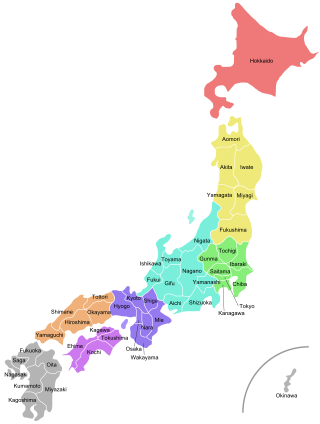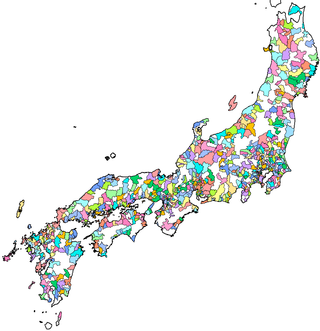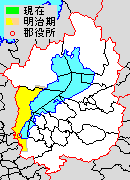
Japan is divided into 47 prefectures, which rank immediately below the national government and form the country's first level of jurisdiction and administrative division. They include 43 prefectures proper, two urban prefectures, one regional prefecture and one metropolis. In 1868, the Meiji Fuhanken sanchisei administration created the first prefectures to replace the urban and rural administrators in the parts of the country previously controlled directly by the shogunate and a few territories of rebels/shogunate loyalists who had not submitted to the new government such as Aizu/Wakamatsu. In 1871, all remaining feudal domains (han) were also transformed into prefectures, so that prefectures subdivided the whole country. In several waves of territorial consolidation, today's 47 prefectures were formed by the turn of the century. In many instances, these are contiguous with the ancient ritsuryō provinces of Japan.

A city is a local administrative unit in Japan. Cities are ranked on the same level as towns and villages, with the difference that they are not a component of districts. Like other contemporary administrative units, they are defined by the Local Autonomy Law of 1947.

In Japan, a district is composed of one or more rural municipalities within a prefecture. Districts have no governing function, and are only used for geographic or statistical purposes such as mailing addresses. Cities are not part of districts.

A city designated by government ordinance, also known as a designated city or government ordinance city, is a Japanese city that has a population greater than 500,000 and has been designated as such by order of the Cabinet of Japan under Article 252, Section 19, of the Local Autonomy Law.
The Japanese addressing system is used to identify a specific location in Japan.

Tokyo City was a municipality in Japan and capital of Tokyo Prefecture which existed from 1 May 1889 until the establishment of Tokyo Metropolis on 1 July 1943. The historical boundaries of Tokyo City are now occupied by the special wards of Tokyo. The defunct city and its prefecture became what is now Tokyo, also known as the Tokyo Metropolis or, ambiguously, Tokyo Prefecture.

Tokyo Prefecture was a Japanese government entity that existed between 1868 and 1943.

Shiga was a district located in Shiga Prefecture, Japan.

Nakanoshima was a town located in Minamikanbara District, Niigata Prefecture, Japan.

Koshiji was a town located in Santō District, Niigata Prefecture, Japan.

Mishima was a town located in Santō District, Niigata Prefecture, Japan.

Santō is a district located in Niigata Prefecture, Japan.

Yamakoshi was a village located in Koshi District, Niigata Prefecture, Japan.

Koshi was a district located in Niigata Prefecture, Japan.
Japanese place names include names for geographic features, present and former administrative divisions, transportation facilities such as railroad stations, and historic sites in Japan. The article Japanese addressing system contains related information on postal addresses.

Western Tokyo, known as the Tama area, Tama region or toka (都下) locally, in the Tokyo Metropolis consists of 30 ordinary municipalities, unlike the eastern part which consists of 23 special wards.

Nagaoka is a city located in Niigata Prefecture, Japan. It is the second largest city in the prefecture, after the capital city of Niigata. As of 4 August 2021, the city had an estimated population of 264,611 in 109,283 households and a population density of 300 inhabitants per square kilometre (780/sq mi). The total area of the city was 891.06 square kilometres (344.04 sq mi).
















